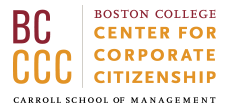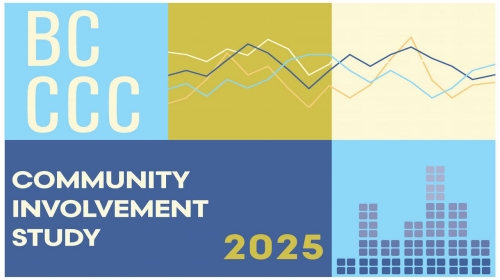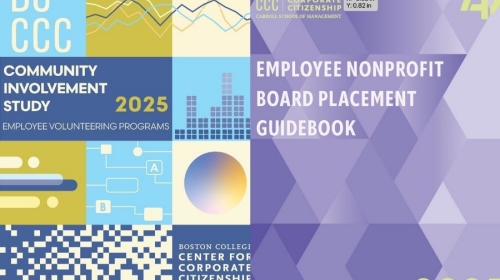WEBINAR: This webinar explores how to measure and communicate your organization's social impact with proven frameworks and strategies that matter to stakeholders.
The One Big Beautiful Bill and Corporate Giving: Insights & Recommendations

On July 4, 2025, President Trump signed the One Big Beautiful Bill (OBBB) into law, introducing changes to tax law that will likely affect some companies' approaches to corporate giving. While corporate philanthropic tax implications are worth unpacking and understanding, the following outline starts by reaffirming the business value of philanthropy—independent of the current context. Take a moment to review how charitable giving creates quantifiable business value, then continue reading below for a look at more OBBB-specific insights and recommendations.
PART 1 | The Other Important Conversation: How Strategic Philanthropy Creates Value Beyond Tax Benefits
Understanding the Full Value Equation
Though we are focused on tax because of the OBBB, corporate charitable giving creates measurable value that far exceeds tax deductions. Recent empirical evidence shows when companies implement strategic giving programs, they can achieve returns of 224% to 400% through combined business benefits and social impact creation[i]. This isn't just about feeling good—it's about creating real, quantifiable value for both businesses and society.
Think of corporate philanthropy as an investment that pays dividends in multiple currencies. While tax deductions might offset 21-35% of donation costs, the total value created through enhanced employee engagement, customer loyalty, innovation, and social impact can be worth three to four times the original investment.
The Business Case: Quantifiable Returns That Compound Over Time
Employee Engagement: The Hidden Multiplier Effect
When we examine how corporate giving affects employees, the numbers tell a compelling story. Recent research shows that 87% of employees report improved perception of their employer when engaged in corporate volunteering and giving programs[ii].
This isn't just about participation numbers. The deeper value comes from what engaged employees contribute to the organization. Higher engagement translates into reduced turnover (saving recruitment and training costs), increased productivity, and enhanced innovation capacity. When employees feel proud of their company's social impact, they become more committed advocates for the organization.
Customer Loyalty and Brand Value: The Market Premium
The connection between corporate giving and customer behavior has become increasingly clear through recent research. A comprehensive 2025 meta-analysis covering 158 studies across 45 countries found that strategic philanthropy significantly enhances firm financial performance through multiple channels[iii]. One of the strongest channels is customer loyalty—customers aware of corporate social responsibility initiatives show higher loyalty rates and intent to purchase[iv].
Innovation Networks: The Unexpected Catalyst
Corporate philanthropy can significantly boost innovation outcomes and market competitiveness. Research suggests that companies engaging in strategic philanthropy gain access to expanded networks, knowledge networks, and gain positive stakeholder attention that benefits their financial performance.[v] These effects prove particularly pronounced in technology-intensive sectors.
When a technology company funds university research or supports STEM education programs, they're not just being charitable. They're building relationships that can lead to research partnerships, talent pipelines, and early access to breakthrough innovations. The philanthropy becomes a bridge to innovation ecosystems that would otherwise remain inaccessible. When insurers support research on fortified building and disaster resilience, they are similarly strengthening their operating context.
Financial Performance: The Bottom-Line Impact
The relationship between strategic philanthropy and financial performance has been extensively studied, with consistent positive results. A 2023 study examining the strategic use of corporate philanthropy found that firms in fragile states—where public goods provision is limited—experience even stronger positive effects on financial performance from their giving programs[vi]. This suggests that philanthropy can be particularly valuable in markets where it helps fill critical social needs.
But even in developed markets, the financial benefits are substantial. Companies achieving higher ESG scores, which include philanthropic activities, demonstrate reductions in cost of capital⁹[vii]. This happens because investors increasingly view strong social performance as an indicator of good management and reduced risk.[viii]
Conclusion: Strategic philanthropy offers competitive advantage
The evidence is clear and compelling: strategic corporate philanthropy creates value far exceeding tax deductions. When companies move beyond checkbook charity to develop integrated giving programs aligned with business strategy and measured through sophisticated frameworks, they unlock multiple value streams that compound over time.
The organizations that recognize this opportunity and invest in building world-class philanthropic programs will enjoy sustainable competitive advantages: more engaged employees, more loyal customers, enhanced innovation capabilities, lower costs of capital, and stronger stakeholder relationships. In an era where business success increasingly depends on social legitimacy and stakeholder trust, strategic philanthropy isn't just nice to have—it's essential for long-term value creation.
The question isn't whether your company can afford to invest in strategic philanthropy. The question is whether you can afford not to. The returns are there for those willing to move beyond traditional approaches and embrace the full potential of business as a force for good.
BCCCC is here to help companies navigate this new landscape, support corporate citizens as they create programs that deliver value for business and society, and keep everyone in this space abreast of changing legislation and policies. If you need help, contact us:
Part 2 | Understanding the New Corporate Giving Landscape
Setting the Stage: What the OBBB 2025 Changed and Why It Matters
Imagine you're a corporation that regularly donates to charity. Under the old tax system, every dollar you gave to qualified nonprofits could reduce your taxable income, starting from the very first dollar. This made charitable giving relatively straightforward from a tax perspective.
Prior to the OBBB, which became law on July 4, 2025, companies were unable to take deductions for charitable contributions exceeding 10% of taxable income. Any excess charitable contributions could be carried forward over the next five years. The new law introduces what's called a "1% floor" for corporate charitable deductions[i]. Think of this floor like a threshold you must cross before receiving any tax benefits. If your corporation has $100 million in taxable income, you now need to donate more than $1,000,000 (1% of $100 million) before you can claim any charitable deduction at all. Any charitable contributions above the 10% ceiling can be carried forward for 5 years. Charitable contributions below the 1% floor can only be carried forward in certain cases, such as if a company exceeds its 10% ceiling.
Over ten years (through 2034), the government estimates this provision will generate $16.6 billion in additional tax revenue[ii]. This change is expected to reduce corporate charitable giving by approximately $45 billion during the same time period, according to EY analyses commissioned by Independent Sector[iii].
Understanding Likely Corporate Responses
To predict how corporations will respond, we need to understand how sensitive donors are to changes in the after-tax cost of giving. Recent research shows that corporate giving has an elasticity ranging from 0.6 to 2.0[iv], meaning that when the cost of giving increases by 10%, corporations reduce their giving by 6% to 20%.
One particularly striking finding suggests that a 1% increase in the tax cost of giving leads to approximately a 4% decline in charitable receipts[v]. Anchoring the value of corporate giving in the tax efficacy of charitable deductions leaves a lot of value on the table. Supporting the competitive context, employees, and communities in which your company operates are actions that also deliver financial value.
A New Pattern of Giving
Most corporate contributions currently fall below the new 1% threshold[vi]. This creates a strong incentive for what researchers call "bunching behavior" —concentrating multiple years of donations into a single year to exceed the threshold. Think of it like this: Instead of donating 1% every year and never qualifying for a deduction, a company might donate nothing for two years, then donate 3% in the third year. This way, they exceed the 1% threshold and can deduct charitable contributions in excess of 1%. While the total giving over three years remains the same, the pattern becomes highly irregular. This bunching creates significant challenges for nonprofit organizations, which will face "feast or famine" cycles that complicate their planning and operations[vii].
Learning from International Experiences
To understand whether this policy approach makes sense, it helps to look at what other countries do. The Organization for Economic Co-operation and Development (OECD) studied charitable tax treatment in 40 countries[viii]. Most developed nations provide corporate charitable deductions without floors, making the U.S. approach relatively unique.
Research on the relationship between corporate tax rates and charitable giving reveals another important insight. There's actually an optimal corporate tax rate for maximizing charitable donations—approximately 27%[ix]. Since the current U.S. rate is 21%, we're already below this optimal point, and adding a floor may further suppress giving.
Strategic Adaptations: How Corporate Leaders May Respond
Based on global evidence and economic research, here are some adaptive strategies that companies might adopt:
1. Temporal Shifting: As discussed, companies could bunch their giving into specific years to exceed the threshold.
2. Reclassification of Expenses: Some corporations may try to reclassify charitable contributions as business expenses under section 162 of the tax code, arguing they expect a financial return commensurate with their donation[x].
3. Program Restructuring: We'll likely see a shift from pure philanthropy toward cause-related marketing or sponsorships with clearer business benefits.
4. International Reallocation: Multinational corporations may shift charitable activities to countries with more favorable tax treatment.
5. Greater Reliance on Corporate Foundations: Moving funds to a nonprofit foundation constitutes a charitable gift. More companies may combine “bunching” tactics to move money into sheltered vehicles such as a foundation or donor advised fund to be allocated to the community in a smoother set of distributions to the community over multiple future years.
The Bigger Picture: Understanding Management Motivations
Research shows that corporate giving is influenced by both profit maximization and managers' aspirations for themselves and their organizations and their core values[xi]. The new rules provide a good opportunity for corporate leaders to have discussions about company core values in addition to financial value. Many aspects of giving contribute to demonstrating values and creating value. It will be important to open conversations up to discussions of what the firm wants to be and achieve with and for its customers, employees, and other stakeholders over a time horizon that extends beyond the tax year.
What This Means for Your Nonprofit Partners
For your nonprofit partners, these changes require strategic adaptation:
- Building Financial Resilience: Organizations need to prepare for more volatile funding patterns by building larger reserves and diversifying funding sources beyond corporate giving.
- Developing New Approaches: Nonprofits should create recognition programs that acknowledge multi-year commitments, even when actual donations come in lumps.
- Emphasizing Business Value: Grant proposals will need to more clearly demonstrate business benefits that might qualify donations as deductible business expenses rather than charitable contributions.
Conclusion: Weighing Costs and Benefits
The OBBB's 1% floor represents a fundamental shift in how the United States approaches corporate charitable tax incentives. While it will generate more government revenue, it comes at the cost of reduced support for nonprofit organizations addressing critical social needs at a time when the government safety nets for vulnerable communities and services are also being cut. The international evidence suggests this approach is unusual among developed nations and may further reduce social cohesion. The empirical evidence suggests the impacts may be larger than policymakers anticipated, making ongoing evaluation essential.
PART ONE SOURCES
[i] Patricio Duran, Fabiola Jeldes, Luciano Ciravegna, Jeffrey S. Harrison, The strategic value of corporate philanthropy: A meta-analysis of the mediating and moderating mechanisms, European Management Journal, 2025, ISSN 0263-2373, https://doi.org/10.1016/j.emj.2025.01.008
[ii] Shweta Bapat, Pooja Upadhyay; Implications of CSR initiatives on employee engagement. Social Responsibility Journal 25 February 2021; 17 (2): 149–163. https://doi.org/10.1108/SRJ-05-2018-0120
[iii]Patricio Duran, Fabiola Jeldes, Luciano Ciravegna, Jeffrey S. Harrison, The strategic value of corporate philanthropy: A meta-analysis of the mediating and moderating mechanisms, European Management Journal, 2025, ISSN 0263-2373, https://doi.org/10.1016/j.emj.2025.01.008
[iv] Niki Glaveli; Corporate social responsibility toward stakeholders and customer loyalty: investigating the roles of trust and customer identification with the company. Social Responsibility Journal 30 April 2021; 17 (3): 367–383. https://doi.org/10.1108/SRJ-07-2019-0257
[v] Jun Hu, Huiying Wu, Sammy Xiaoyan Ying, Wenbin Long, Relative-to-rival corporate philanthropy, product market competitiveness, and stakeholders, Journal of Contemporary Accounting & Economics, Volume 17, Issue 1, 2021, 100237, ISSN 1815-5669, https://doi.org/10.1016/j.jcae.2020.100237
[vi] Choi, Seungho, Park, Raphael, Xu, Simon 2023/02/09, Review of Finance, Vol27, The Strategic Use of Corporate Philanthropy: Evidence from Bank Donations https://doi.org/10.1093/rof/rfad003
[vii] Dietmar Ernst & Florian Woithe, 2024. "Impact of the Environmental, Social, and Governance Rating on the Cost of Capital: Evidence from the S&P 500," JRFM, MDPI, vol. 17(3), pages 1-15, February. https://ideas.repec.org/a/gam/jjrfmx/v17y2024i3p91-d1342225.html
[viii] Coelho, R., Jayantilal, S., & Ferreira, J. J. (2023). The impact of social responsibility on corporate financial performance: A systematic literature review. Corporate Social Responsibility and Environmental Management, 30(4), 1535-1560. DOI: 10.1002/csr.2446
PART TWO SOURCES
[i] Polsinelli, The “One Big, Beautiful Bill” — What You Need to Know” July 14, 2025 https://www.polsinelli.com/publications/one-big-beautiful-bill-guide
[ii] Congress of the United States, JCX-35-25 “Estimated Revenue Effects Relative To The Present Law Baseline Of The Tax Provisions In “Title VII – Finance” Of The Substitute Legislation As Passed By The Senate To Provide For Reconciliation Of The Fiscal Year 2025 Budget” July 1, 2025 https://www.jct.gov/publications/2025/jcx-35-25/
[iii] EY, prepared on behalf of the Independent Sector, June 2025 https://independentsector.org/wp-content/uploads/2025/06/Ernst-Young-Study-on-1-Floor-on-Corporate-Charitable-Donations.pdf
[iv] EY, prepared on behalf of the Independent Sector, June 2025 https://independentsector.org/wp-content/uploads/2025/06/Ernst-Young-Study-on-1-Floor-on-Corporate-Charitable-Donations.pdf
[v]National Bureau of Economic Research. "Tax Incentives for Charitable Giving: New Findings from the TCJA." 2024. https://www.nber.org/papers/w32737
[vi] Duquette, Nicolas. "Do tax incentives affect charitable contributions? Evidence from public charities' reported revenues." Journal of Public Economics, 2016, vol. 137, issue C, 51-69. DOI: 10.1016/j.jpubeco.2016.02.002
[vii] The Nonprofit Alliance. "Tax Reform & Charitable Giving: What It Means for Your Organization and Donors." 2025. https://tnpa.org/tax-reform-charitable-giving-what-it-means-for-your-organization-and-donors/
[viii] IBID
[ix] OECD. "Taxation and Philanthropy." November 2020. https://www.oecd.org/en/publications/taxation-and-philanthropy_df434a77-en.html
[x] Baker, Paul L. and Dawson, Chris. "The corporation tax elasticity of charitable donations." Journal of Economic Behavior & Organization, October 2020. https://doi.org/10.1016/j.jebo.2020.07.008
[xi] Nguyen, N. T. T., Nguyen, N. P., & Hoai, T. T. (2021). Ethical leadership, corporate social responsibility, firm reputation, and firm performance: A serial mediation model. Heliyon, 7(4). https://www.cell.com/heliyon/pdf/S2405-8440(21)00912-9.pdf
Related Content
RESEARCH BRIEF - Researchers investigated how ESG activities help or hurt financial performance, using nine years of data from over 1,200 global companies.
RESEARCH BRIEF - Researchers analyzed 4 US energy exchange-traded funds (ETFs) over 15 years, including 2 dirty energy funds tracking fossil fuel companies and 2 clean energy funds tracking renewable energy companies.
RESEARCH BRIEF - Researchers conducted a survey, which measured perceptions of CSR and ethical leadership within the manufacturing and service industries.
WEBINAR: This webinar explores how corporate giving will be reshaped by the One Big Beautiful Bill. Hear directly from corporate citizenship leaders as they share innovative, real-world strategies that deliver impact for communities and results for business.
This study explores shifting trends in employee volunteering, corporate giving, and other means of corporate community involvement.
This guidebook offers insights on placing employees in nonprofit board service roles.
This study explores shifting trends in employee volunteering, corporate giving, and other means of corporate community involvement.










